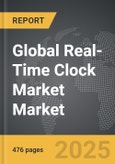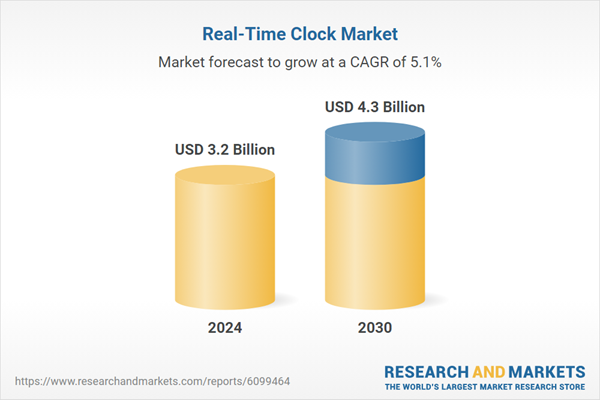Global 'Real-Time Clock' Market - Key Trends & Drivers Summarized
Is The Humble Real-Time Clock Still Vital In Today's Hyperconnected Devices?
Real-time clocks (RTCs) may appear as modest components, but they serve a mission-critical function in a wide range of electronic systems - maintaining precise timekeeping even during power-down conditions. Found in devices from industrial controllers and medical instruments to consumer electronics and automotive dashboards, RTCs enable scheduled operations, timestamping, and synchronization. Their importance is growing with the proliferation of battery-powered and always-on devices, which demand low-power yet reliable timing solutions. In sectors like telecommunication, data logging, and smart metering, real-time accuracy is essential for diagnostics and audit trails. Additionally, in the era of the Internet of Things (IoT), RTCs play a pivotal role in power management by coordinating wake-up events and low-duty cycle operations. As digital transformation accelerates across industries, RTCs are proving that even simple, legacy components can remain central to sophisticated modern systems.How Are Technological Enhancements Redefining RTC Capabilities?
Modern RTCs are evolving to meet the stringent requirements of high-precision, ultra-low power, and ruggedized applications. Advanced features such as temperature-compensated crystal oscillators (TCXOs) and digital trimming are improving timekeeping accuracy across wide thermal ranges. Integrated power management circuits and trickle-charging capabilities are enhancing battery life in RTC-backed systems. Some RTCs now include built-in memory registers, tamper detection, and interrupt outputs to support secure and responsive operation in embedded environments. Newer designs also offer I²C and SPI interfaces, facilitating seamless communication with microcontrollers and processors. Ultra-low standby currents, often in the nanoamp range, make RTCs viable for compact and wearable electronics. Furthermore, the emergence of MEMS-based oscillators is offering greater resilience in high-vibration or shock-prone environments. These enhancements are making RTCs smarter, more robust, and indispensable in next-gen designs.Which Sectors Are Fueling Demand For Real-Time Clock Integration?
Real-time clocks are witnessing strong demand from sectors with growing dependence on autonomous, energy-efficient, and data-sensitive systems. The automotive industry is embedding RTCs in electric vehicle (EV) dashboards, infotainment units, and advanced driver-assistance systems (ADAS) to track logs and power events. In healthcare, RTCs are used in wearable medical devices and diagnostic equipment for time-stamped patient monitoring. The rise of Industry 4.0 has led to RTC integration in industrial automation, robotics, and remote sensors to synchronize operations and enable predictive maintenance. In the consumer segment, RTCs are embedded in smart appliances, fitness wearables, and IoT hubs. Telecommunications and server infrastructures also rely on RTCs for time-sensitive data transfer and uptime tracking. As these sectors evolve toward intelligent, connected, and mission-critical systems, RTC demand is steadily expanding.What's Driving The Growth Of The Global Real-Time Clock Market?
The growth in the real-time clock market is driven by advancements in low-power IC design, increasing deployment of IoT and edge devices, and rising demand for precision timekeeping in industrial automation and consumer electronics. Technologically, improvements in oscillator stability, power consumption, and integration with microcontrollers are enhancing RTC utility and performance. End-use growth is fueled by the need for consistent time tracking across EVs, medical devices, smart meters, and industrial controllers. The global transition toward battery-operated and always-on electronics is necessitating accurate timekeeping with minimal energy drain. Moreover, the rising trend of smart wearables and embedded systems in portable devices is contributing to RTC volume growth. The expansion of smart cities and next-gen telecom infrastructure, including 5G, is further amplifying the market need for robust and synchronized time solutions.Report Scope
The report analyzes the Real-Time Clock market, presented in terms of market value (US$). The analysis covers the key segments and geographic regions outlined below:- Segments: Interface (Inter-Integrated Circuit, Serial Peripheral Interface); Mounting Type (Surface Mount, Through Hole); Operating Voltage (1V - 2V, 2.1V - 3.5V, 3.6V - 6V); End-Use (Energy & Utility, Consumer Electronics, Automotive, Industrial, IT & Telecommunication, Other End-Uses).
- Geographic Regions/Countries: World; United States; Canada; Japan; China; Europe (France; Germany; Italy; United Kingdom; Spain; Russia; and Rest of Europe); Asia-Pacific (Australia; India; South Korea; and Rest of Asia-Pacific); Latin America (Argentina; Brazil; Mexico; and Rest of Latin America); Middle East (Iran; Israel; Saudi Arabia; United Arab Emirates; and Rest of Middle East); and Africa.
Key Insights:
- Market Growth: Understand the significant growth trajectory of the Inter-Integrated Circuit segment, which is expected to reach US$2.9 Billion by 2030 with a CAGR of a 4.1%. The Serial Peripheral Interface segment is also set to grow at 7.2% CAGR over the analysis period.
- Regional Analysis: Gain insights into the U.S. market, valued at $870.8 Million in 2024, and China, forecasted to grow at an impressive 7.9% CAGR to reach $848.5 Million by 2030. Discover growth trends in other key regions, including Japan, Canada, Germany, and the Asia-Pacific.
Why You Should Buy This Report:
- Detailed Market Analysis: Access a thorough analysis of the Global Real-Time Clock Market, covering all major geographic regions and market segments.
- Competitive Insights: Get an overview of the competitive landscape, including the market presence of major players across different geographies.
- Future Trends and Drivers: Understand the key trends and drivers shaping the future of the Global Real-Time Clock Market.
- Actionable Insights: Benefit from actionable insights that can help you identify new revenue opportunities and make strategic business decisions.
Key Questions Answered:
- How is the Global Real-Time Clock Market expected to evolve by 2030?
- What are the main drivers and restraints affecting the market?
- Which market segments will grow the most over the forecast period?
- How will market shares for different regions and segments change by 2030?
- Who are the leading players in the market, and what are their prospects?
Report Features:
- Comprehensive Market Data: Independent analysis of annual sales and market forecasts in US$ Million from 2024 to 2030.
- In-Depth Regional Analysis: Detailed insights into key markets, including the U.S., China, Japan, Canada, Europe, Asia-Pacific, Latin America, Middle East, and Africa.
- Company Profiles: Coverage of players such as Aetion, Inc., Atropos Health, BEKHealth, Cerner Corporation, Clarify Health Solutions and more.
- Complimentary Updates: Receive free report updates for one year to keep you informed of the latest market developments.
Some of the 44 companies featured in this Real-Time Clock market report include:
- Abracon LLC
- Analog Devices, Inc.
- Diodes Incorporated
- Epson Electronics America, Inc.
- Integrated Device Technology, Inc.
- Maxim Integrated Products, Inc.
- Micro Crystal AG
- Microchip Technology Inc.
- Nisshinbo Micro Devices Inc.
- NXP Semiconductors N.V.
- Renesas Electronics Corporation
- Ricoh Electronic Devices Co., Ltd.
- ROHM Co., Ltd.
- Samsung Electronics Co., Ltd.
- Seiko Instruments Inc.
- SiTime Corporation
- STMicroelectronics N.V.
- Texas Instruments Incorporated
- TheoryCircuit
- ZMDI (Zentrum Mikroelektronik Dresden AG)
This edition integrates the latest global trade and economic shifts into comprehensive market analysis. Key updates include:
- Tariff and Trade Impact: Insights into global tariff negotiations across 180+ countries, with analysis of supply chain turbulence, sourcing disruptions, and geographic realignment. Special focus on 2025 as a pivotal year for trade tensions, including updated perspectives on the Trump-era tariffs.
- Adjusted Forecasts and Analytics: Revised global and regional market forecasts through 2030, incorporating tariff effects, economic uncertainty, and structural changes in globalization. Includes historical analysis from 2015 to 2023.
- Strategic Market Dynamics: Evaluation of revised market prospects, regional outlooks, and key economic indicators such as population and urbanization trends.
- Innovation & Technology Trends: Latest developments in product and process innovation, emerging technologies, and key industry drivers shaping the competitive landscape.
- Competitive Intelligence: Updated global market share estimates for 2025, competitive positioning of major players (Strong/Active/Niche/Trivial), and refined focus on leading global brands and core players.
- Expert Insight & Commentary: Strategic analysis from economists, trade experts, and domain specialists to contextualize market shifts and identify emerging opportunities.
Table of Contents
Companies Mentioned (Partial List)
A selection of companies mentioned in this report includes, but is not limited to:
- Abracon LLC
- Analog Devices, Inc.
- Diodes Incorporated
- Epson Electronics America, Inc.
- Integrated Device Technology, Inc.
- Maxim Integrated Products, Inc.
- Micro Crystal AG
- Microchip Technology Inc.
- Nisshinbo Micro Devices Inc.
- NXP Semiconductors N.V.
- Renesas Electronics Corporation
- Ricoh Electronic Devices Co., Ltd.
- ROHM Co., Ltd.
- Samsung Electronics Co., Ltd.
- Seiko Instruments Inc.
- SiTime Corporation
- STMicroelectronics N.V.
- Texas Instruments Incorporated
- TheoryCircuit
- ZMDI (Zentrum Mikroelektronik Dresden AG)
Table Information
| Report Attribute | Details |
|---|---|
| No. of Pages | 476 |
| Published | December 2025 |
| Forecast Period | 2024 - 2030 |
| Estimated Market Value ( USD | $ 3.2 Billion |
| Forecasted Market Value ( USD | $ 4.3 Billion |
| Compound Annual Growth Rate | 5.1% |
| Regions Covered | Global |









